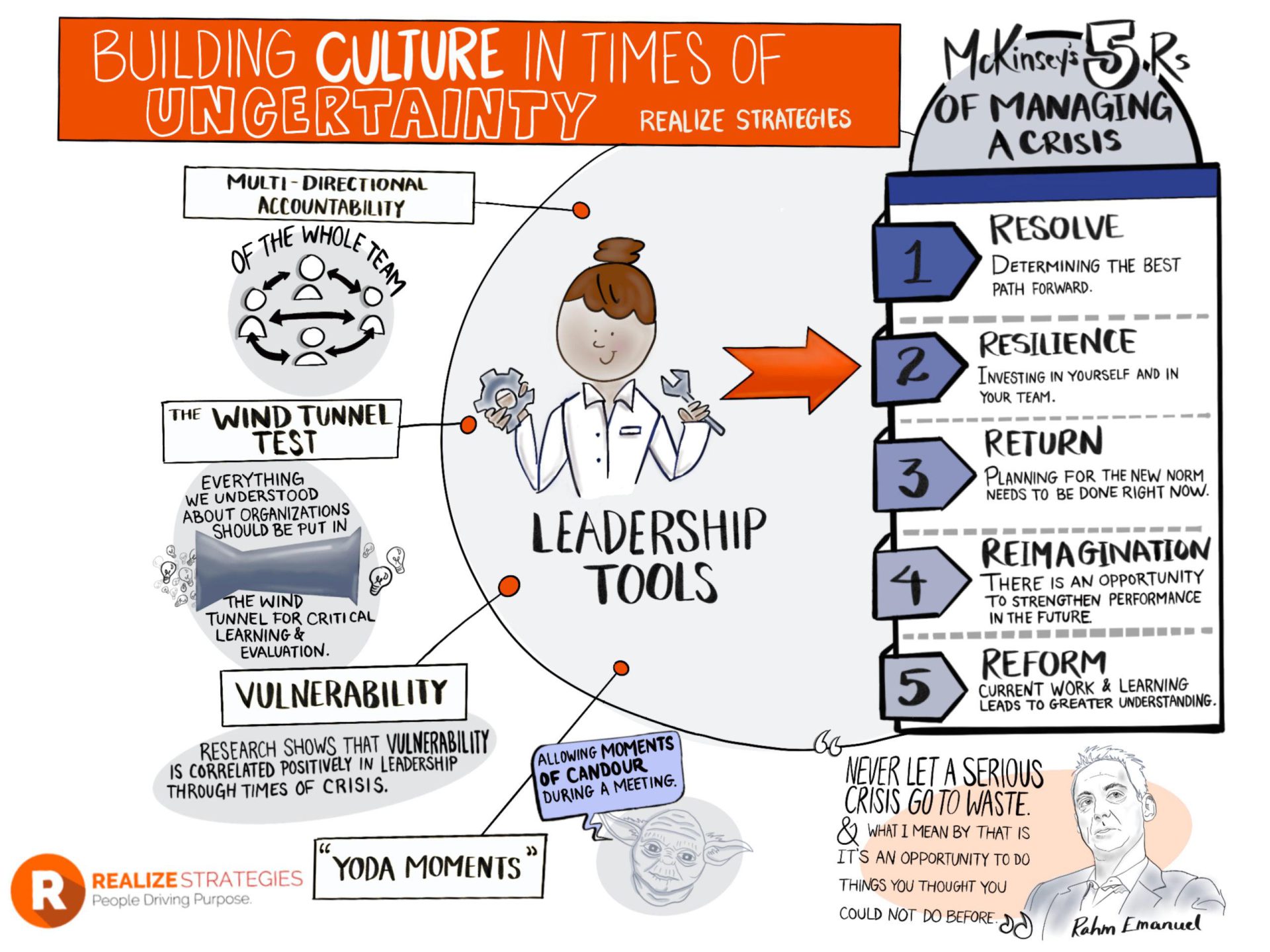Building Culture in Times of Uncertainty
Published on April 21, 2020
The future is extremely uncertain for many of us right now. As leaders, it’s easy to focus on and worry about the livelihood of the organization you’re helming and to latch onto protecting the financials and start cutting costs wherever it’s feasible. However, it’s important to not forget who makes the core of your organization – the people. Each individual employee helps keep the engine of the organization running and ensuring that your organization keeps building, innovating, and delivering your products and services to your clients and community. While the pandemic has sent waves of upheaval and instability around the globe, it has also given us an opportunity to really understand the core of our organizations and to properly invest in it.
At Realize, we always say that people are at the core and strong, healthy culture builds organizational resiliency. In this case, we’re defining “culture” as the prevailing mindset within an organization. Culture determines how we respond in times of crisis. We’re not just making it up when it comes to the importance of a strong workplace culture – studies have shown that organizations with strong healthy cultures experienced 15% greater employee productivity, 26% less employee turnover, up to 30% greater customer satisfaction levels, and 100% more in in unsolicited job applications.
4 things you can do and invest in to build a strong culture in times of uncertainty
1. Engage your employees
During the pandemic, every organization has to pivot and adapt to the new normal. This is an opportunity for your organization to rejig and experiment in ways. Welcome your staff to have these authentic conversations with leadership during these uncertain times. Foster trust and respect by engaging them in regular scenario planning meetings where big questions like “What are we facing?”, “How might we…” and “What if?” are laid out on the table for frank discussion. Listen to what’s shared for valuable and diverse insight. Use these open conversations as a way of putting every facet of the organization through the “Wind Tunnel” stress test – imagine passing each idea through a high-speed wind tunnel. Not every can or should survive in a wind tunnel – only the strongest ideas and pieces will and those can help carry you through this crisis.

We ourselves at Realize having a standing agenda item in our weekly team meetings for having open conversations about what the pandemic means for us as a team and organization, and also recognizing and being transparent about how there is much uncertainty and change. We don’t shy away from not having all the answers – instead, we share what we do know, and open the floor for suggestions and discussion ranging from weekly updates on how the organization is doing, what do we think is coming down the pipeline, how is everyone doing mentally and physically, and how can we prepare for and thrive in this new evolving normal.
Part of the challenge of building culture and resilience is managing ahead of it. Culture becomes stronger as teams rally around working together for a common purpose, enabling everyone to come out of this crisis stronger and with a much stronger understanding about who the organization is and why it exists. This doesn’t mean that there won’t be structural changes to the organization, or that lay-offs can be avoided, or that this process will even be easy.
But by genuinely engaging with your employees, you will stand a much better chance at coming out of any crisis with a fundamentally stronger organization, a much more resilient culture, and be ready for the next potential wave of setbacks in the fall or the next challenge that we can’t even see yet. Teams will only thrive during a crisis when they share the same goals and vision of the leader and are not just left in the dark and dictated at by leadership.
2. Vulnerability and authenticity
There is a preconception that leaders cannot be vulnerable to their team; however, all of the research shows that vulnerability is correlated positively in leadership, and in management, through times of crisis. Whether it be by expressing that your mental health is affected by working from home, accepting that productivity is different, or by sharing that you’re feeling the effects of the pandemic just as much as everyone else, this vulnerability expresses authentic humanity, something that resonates with and unites us all now, more than ever.
It can be easy to lose the authenticity and vulnerability when everyone is working from home and feeling that they cannot express their stress and difficulties. To help create an environment that people feel safe to be vulnerable in, we recently introduced “Yoda moments” with great success. Coined by Keith Ferrazzi, CEO of Ferrazzi Greenlight, “Yoda moments” are a way to encourage candor and vulnerability wherein a pre-assigned Yoda asks at critical points during a meeting “So what’s going on here that nobody’s talking about?”, making it a safe space to express differing and potentially risky thoughts and ideas.
3. Experimentation and innovation
The pandemic forced many of us to change, whether we wanted to or not. For example, many organizations, particularly larger organizations in the US, are very resistant to the idea of remote work. Reasons included leadership not trusting whether staff would “actually be working” without oversight, fears around communication problems, and more. But with social distancing and shelter-in-place policies, countless of non-essential businesses have had to rapidly transition and embrace remote work as the new normal. Statistics have shown that remote employees were 24% more likely to feel happy and satisfied, 9% more engaged in their jobs, 13.5% more productive than their office-based counterparts, and 50% less likely to quit. From an operations perspective, many organizations are now rapidly testing and launching new production distribution and delivery methods in order to stay in the game and best serve their clients. Health and wellness policies are also coming under scrutiny and having companies consider if what they currently offer is enough.
Statistics have shown that remote employees were 24% more likely to feel happy and satisfied, 9% more engaged in their jobs, 13.5% more productive than their office-based counterparts, and 50% less likely to quit.
4. Accountability
Multi-direction accountability – in which each individual is accountable to everyone on the team and not just the leader – is vital to the success of a virtual team. By acknowledging and being transparent as to how everyone’s work fits together and the importance of the different roles, it removes some of the competitiveness and decreases insecurity and internal tension. It is critical that when managing virtual teams, leaders set a clear understanding that we will all cross the line together, no one is running faster than anyone else, and that we are all working towards the same goal to set a strong unifying culture.
McKinsey wrote about their 5 R’s of Managing a Crisis which is all centred around culture and what leaders should do:
- Resolve: Determine the scale, pace, and depth of action required.
- Resilience: Invest in your team and yourself to best equip your organization to handle immediate problems as well as prepare for future upheaval. Sustain your team by investing in everyone’s development while acknowledging that difficult decisions may need to be made.
- Return: Planning for the return to the new normal needs to be done right now. You cannot wait until the new normal is officially in place – how you can manage teams, process, communications, and strategic decisions right now will determine how successful you are coming out of this crisis and how strong and resilient the team and culture is. Stress test in the summer months what worked, what didn’t, and continue planning what to do when the next COVID-19 wave hits or if another unexpected event happens.
- Reimagination: This is an opportunity to strengthen future performance. The current crisis is revealing the vulnerabilities within our organizations but also gives us an opportunity to reinvent the future and strengthen future performance by addressing said vulnerabilities.
- Reform: Current work and learning leads to greater understanding.
The most fundamental piece of being a strong and useful leader during a crisis is to be authentic, honest, and vulnerable. Set the direction the organization will be moving in but also step back and allow others with strengths and expertise you do not have to speak up and lead. Teams can and will accept difficult decisions if they truly believe the leader is giving them an honest outline of reality and include them in discussions about the future.
Contributors




